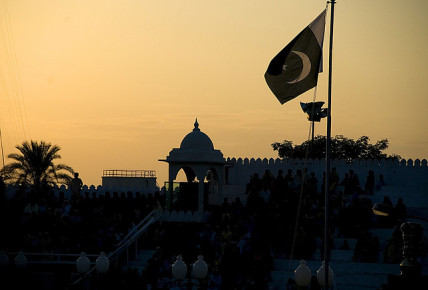
Photograph by bm1632
Pakistan is at a crossroads. Its fragmented internal and external political situation is gradually inching towards chaos. The country is facing secessionist movements in the Balochistan and Sindh provinces; religious terrorism in Punjab, the Tribal Areas, and Khyber Pakhtunkhwa (KPK) province; war on its Afghan border; continued discontent with neighbouring India; disagreements with the US; and a distancing from Saudi Arabia. The key to understanding these current crises is in the understanding of state building and statecraft.
Ethnography of State Building
Pakistan’s foreign policy is deeply rooted in the partition of British India, and thereby in the early period of its state building.
In 1946, Pashtuns, under Khan Abdul Ghaffar Khan, were against the idea of Pakistan. They were considered an internal security threat by the Muhajir (refugees from India) leadership of the All India Muslim League (AIML), and as a result the NWFP (now KPK) Provincial Legislative Assembly which housed a congressional majority was dismissed in September 1947.
Sindh was treated similarly. G.M. Syed, who tabled and lobbied the historic Resolution of Pakistan in the Sindh Legislative Assembly before the partition, became an arch opponent of it in 1946 and resigned from the AIML. The Sindh government was dismissed in April 1948 due to their refusal to separate Karachi from Sindh in order to establish a capital of the newly formed country and its resistance of violence against the Hindu population of the area and their exodus.
Balochstan was neither part of the partition plan nor was it part of Pakistan in 1947. Qalat Khanate (Balochi speaking Balochistan) was an independent sovereign state with a bicameral parliament, cabinet and a head of the state. Balochistan was annexed to Pakistan in 1948.
Sindhis, Balochis and Pashtuns were perceived to be a security concern by the Punjabi-Muhajir AIML leadership, military and civil bureaucracy, and were excluded from the state building process. The foreign policy making of Pakistan, excluding Zulfiqar Ali Bhutto’s period of 1972-1977, was been envisioned, steered, and implemented by the ethnic-Punjabi majority army in association with Urdu Speaking the Muhajir majority bureaucracy. If analyzed on the ethnic lines, the Ministry of Foreign Affairs in Pakistan have employed fewer ethnic Sindhis and Balochs in last sixty years then the ethnic Punjabis and Urdu speaking Muhajirs employed during last sixty months.
In 1947, the army was almost entirely Punjabi, whilst the civil bureaucracy and the AIML leadership was Muhajir. The AIML leadership being refugees did not have an electoral constituency in Pakistan, and there democracy was less aligned with their interests. Moreover, Jinnah’s practical detachment from state-building due to his deteriorated health led Pakistan towards a non-democratic political model based on a civil bureaucracy-military-aristocracy triumvirate of Punjabi and Urdu speaking refugees, which kept the other ethnicities and provinces away from the processes of state craft. Pakistan’s foreign policy towards India could be defined as a reaction of the Punjabi and Urdu-speaking refugees towards the violence occurred during the partition.
Since the formation of Pakistan, Pashtuns were sidelined to prevent their imagined annexation with Afghanistan. The NWFP region was accorded to British India under Durand Line agreement in 1893 by Afghan King Emir Amanullah Khan after Anglo-Afghan War in 1839. The inclusion of Pashtuns in the security establishment only became possible after the takeover by General Ayub Khan and General Yahya Khan, both from NWFP, with their numbers further increased by General Ziaul Haq during the “Afghan Jihad” period of the cold war.
Can Borders Alone Decide Policies?
Pakistan’s foreign policy and strategic vision consists of two basic interconnected factors – inward external security and outward internal concerns defined within the context of its relationship with Afghanistan and India. Historically, Pakistan has worked within the boundaries of alliances with the US, Saudi Arabia, and China, serving international interests that suit the Pakistani civil-military elite, and supports retrogressive Arab nationalism manifested into the extremist Islamist movements. After sixty years of the country’s existence, its foreign policy triangle has evolved into a Central Asia – China and Iran axis. Pakistan’s security in broader terms is defined by its immediate neighbours and inversely associated with internal concerns and interests, which are ironically defined by a very much non-representative establishment of the country.
A review of Pakistan’s border “security concerns” is alarming. The country faces aggression at the upper eastern border of divided Punjab and Kashmir; their desert and costal borders of Sindh with India capitalized by the non-hostile-to-India Sindhi demography; an insurgency in Pakistani and Iranian Balochistan at the western lower borders; a porous borders with Afghanistan; and over its mountainous border with China, there is a continuing insurgency in the Xinjiang province.
Pakistan today is not thinking beyond the creation of a stable Afghanistan with a Pakistan-friendly Pashtuns population. It wrongly believes that the emergence of such a neighbor will minimize security concerns of nationalist resentment in Pashtun populated KPK, Northern Balochistan and Federally Administered Tribal Areas (FATA). Additionally, the Taliban are recognized strategic assets of Pakistan, and Pakistan already has fears of Afghanistan turning into a hostile country after the ISAF withdrawal in 2014.
Statecraft Dispositions
These indicators of state crises will only dissipate if Pakistan adopts a paradigm shift in its foreign policy along with extensive reforms in its federal structure and demographic chemistry of the state apparatus.
Fallacies in politics are always counterproductive. That Pashtun strategy is framed on the notion of Talibanization along with the Durand Line has become a paradox. Secular Pashtun political forces within Pakistan are still able to carve out new positive corridors, whilst the Taliban have tactically killed the majority of tribal elders in the KPK to take hold of the area. However, there are many veteran tribal elders in Pakistan with greater ties on the other side of the Durand Line that could be beneficial for the true peace initiatives. This requires 180 degree shift in Pakistan’s Afghanistan policy. Strategic blunders like dividing Pashtuns to ensure internal security have already led Pakistan into blind alley. Pakistan needs to support the reconstruction along with reconciliation in Afghanistan; restraining the Taliban; and carrying out reforms and development in the FATA and KPK.
Besides, Pakistan’s Afghanistan policy is wrapped with its historic concerns of India, which should now be addressed. If ISAF is withdrawing by 2014 without leaving behind a sovereign capable government in Afghanistan, it may prove to be disastrous for the stability in South Asia. Therefore, political solution is the only passage.
A positive settlement in Afghanistan is only possible when US, India, Iran, Pakistan, Central Asia and China devise a roadmap along with observers like Germany, Turkey and Saudi Arabia for the state building and reconstruction of Afghanistan.
A 180 degree shift in Pakistan’s India policy would only be possible if state chemistry in Pakistan is altered. For the introduction of this higher degree strategic shift in its India policy, Pakistan must first address the need for internal reforms within the country such as restructuring its federal system and ensuring all major ethnic groups can participate in statecraft.
The energy needs of Pakistan are pushing it towards Central Asia, Iran, and Eurasia. Without a stable Afghanistan, interaction with these Central Asian States and Eurasia is impossible, and the survival of Pakistan will come primarily from the resolution of intra-state conflicts, federal reforms, the separation of religion from the state, and from providing equal rights to all ethnic and religious minorities. It also requires revisiting the matrix of the state’s legitimacy which is based on a two-nation theory; internal stability and security concerns vis-à-vis neighbouring countries.
The Cost of Pakistan’s Interventions
Pakistan army overwhelmingly consists of ethnic Punjabis and the Muhajir community. Its engagement in Afghanistan has proved to be highly beneficial for the military as well as civil entrepreneur of Punjab in economic and monetary terms. However, it is Sindh that has paid the price of Pakistan’s Afghan interventions, including the war against terror, in the form of the influx of refugees. Sindh, the only secular province of Pakistan, is now also facing the possibility of being “Talbanized” by the security establishment as the supply of ISAF forces and access of land locked Afghanistan to international trade is through Karachi, the capital of Sindh. Unfortunately, the international community that is engaged in the reconstruction of Afghanistan has never pressurized Pakistan to ensure the federal rights of Sindh province. As a reaction to such an oppressive policy, more than one million people of Sindh marched in the city of Karachi under the banner of “Freedom March 2012” and demanded the international community to intervene for the freedom of Sindh. A similar situation is also happening in Balochistan where the struggle for freedom has been underway since 2002.
The Road to Transformation
Pakistan’s behavior as a state is a reflection of its early state building patterns; an extremely centralized federalism; a demographic hegemony providing for the interests of the dominant Punjab province; ethnic uniformity in the security establishment; a demoralized and fragmented civilian population; the militarization of civil institutions; and a state ideology with the imposition of Saudi Salafaism on the Sunni Hanafia majority.
A paradigm shift in the definition of Pakistani state-doctrine is a prerequisite for the transformation of country. Extensive federal reforms accompanied by demographic and geographic securities for the federal provinces and their historical people with proportionate participation in the security regime and civil bureaucracy are required alongside the liberalization of society. Greater autonomy and authority for the civilian leadership would then become unavoidable, minimizing the Army’s role in the leadership of the country.
The transformation into a viable state through federal reforms and restructuring state-doctrine and the paradigm shift in the foreign policy vision are interdependent. Pakistan requires a sociopolitical, federal, and state transformation. If this is not attained, both anarchy and chaos may prevail, threatening a human catastrophe or a situation that will lead to the creation of new break-away sovereign states.





1 Comment
“No Basis Now for Pakistan to Exist”
By
Dr. Ahme3d Makhdoom
Pakistan was created on the basis of religion – Islam! So-called Muslims,
of this unworthy ‘n uneducated, ignominious ‘n incompetent, ill-conceived and
ill-gotten state, are killing their own brothers and sisters in Islam, the Muslims
– as they did in Bangladesh! World did not NOTICE then! Bengal fought,
sacrificed millions of lives and FREED themselves from the chains of slavery of
the savages from Pakistan!
Today again, as it has been again and again since 1971, when after the ignoble
‘n inglorious defeat of Pakistani Armed Forces and devilish rulers in the
valleys, plains and fields of brilliant Bengal, the vultures have been feeding
themselves merrily on the mass, flesh and blood of the innocents in Sindh and
Balochistan!
These same barbaric Armed Forces of Pakistan together with their
venomous Intelligence Services and wicked vitriolic politicians and rulers, the
barbarians and brutes of “ISLAMIC REPUBLIC OF PAKISTAN” are conducting
massacres with savagery and impunity in the Land of the Sufis, Bhaggats and
Joggees, my Motherland, Sindh! And, the ‘civilised’ world SLEEPS deep,
hibernates long and SHUT their Eyes dark!
Pakistan has LOST its LEGITIMACY! Pakistan has abused and shattered the very basis
of its very CREATION – Islamic slogan and constitution! Pakistan MUST NOT EXIST
anymore! Pakistan must be tried in the Human Rights Courts of Law and Justice
and be ignominiously HANGED on the Gallows of Justice, Fairness and Humanity!
Stop this brutality and savage Genocide of Shias, Hindus, Christians, Ahmedis,
Sindhis and Balochs in this rogue, terrorist and failed state of Pakistan! Enough
is Enough! STOP IT NOW!
And, I am just a suffering, simple, naive and gullible Son of Sindh,
Dr. Ahmed Makhdoom
Brunei Darussalam